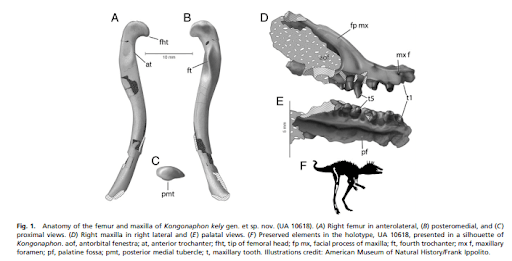
Tiny Bug Slayer! Kongonaphon kely, a new dinosaur cousin from the Triassic of Madagascar
Share
Tiny Bug Slayer! Kongonaphon kely
We here at Fossil Crates love fossils in all their forms! I was reading through a paper published in July and thought this one was too cute to not share! Kongonaphon kely (“Tiny bug slayer”) caught my eye primarily because of its size, about 4” tall as an adult, and the fact that the teeth microwear patterns indicate it ate hard-shelled insects.
To make sure they weren’t looking at simply a hatchling or even an embryo the paleontologists conducted a number of tests commonly used to determine if an animal is a juvenile. They performed a histological analysis using a thin section of the tibia and found two Lines of Arrested Growth (LAG). If you think of LAGs as a kind of tree ring but for limb bones, you have the right idea. The fact it has 2 LAG lines means it grew at least 2 “seasons”, which means it couldn’t be a hatchling. The tail bone was fully fused. In young reptiles the top of the vertebra isn’t fused solidly to the centrum until it reaches adulthood, which means a vertebra can be thought of consisting of 2 pieces. They also noted the outer bone texture is made up of compact bone, a classic adult animal trait, as juvenile reptiles have fibrous bone as well (fibrous bone has more vascular channels which are important for fast growth).
Kongonaphon was collected in Madagascar rocks that are 242-227 million years old (Triassic age). It is known from a fragmentary right upper jaw (maxilla), a mostly complete right femur (1 ½” long!), various limb elements, and a tail bone. This time frame is important in the evolution of dinosaurs as the oldest known dinosaurs are from around 230 million years ago, so this critter was hopping about before the dinosaurs.
The animal belonged to the Lagerpetidae, which is basically a collection of animals that includes dinosaurs and pterosaurs, the winged flying reptiles that flew alongside the dinosaurs but were not dinosaurs themselves, but rather first cousins. The early origins of archosaurs, the group of animals that dinosaurs and pterosaurs (among other animals) belong to have been difficult to determine. In a future blog, I will go over taxonomy and broad groupings of dinosaurs and their relatives but for this musing, I have included a cladogram, a visual representation of how paleontologists view the relationships of animals.

Cladogram from Nesbitt et al 2017
The figure below shows the femur, the jaw, and a silhouette of what the authors believed the animal looked like. So cute! Notice they drew it with tiny hairs. One thought is some of the reptiles had tiny filaments on their body that may have given rise to the “hairs” on pterosaurs, the fur on a mammal, and feathers in birds. It is more complicated than that but I’ve been advised I tend to go into the weeds too often so I’ll leave it at that. :-)

Image from Kammerer et al 2020
The femur was nearly complete and measured in at a whopping 1.5” long. I am used to working with sauropod femora 5-6’ long, or 50x larger than this little guy.
The jaw fragment was less than ½” long and still had a few teeth intact. I can’t even fathom working with material this tiny. I am astounded they even found it!

Image from Kammerer et al 2020
The teeth were examined in a scanning electron microscope, a picture of which is below.

Image from Kammerer et al 2020
If you have ever wondered what a tooth looks like that is used to eat hard-shelled beetles and insects, wonder no more! The image below is a closeup of the one above. If you look closely you will see wrinkles and pits, these are classic hard-shell bug-eating signs that are present on animals like rodents that eat hard-shelled bugs today.

Image from Kammerer et al 2020
I would love to see this little creature hopping about, hunting insects, bounding about on two legs!
Thank you kindly!
BC